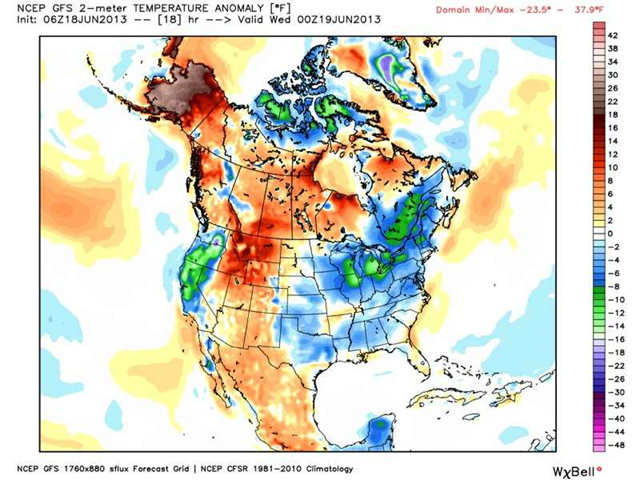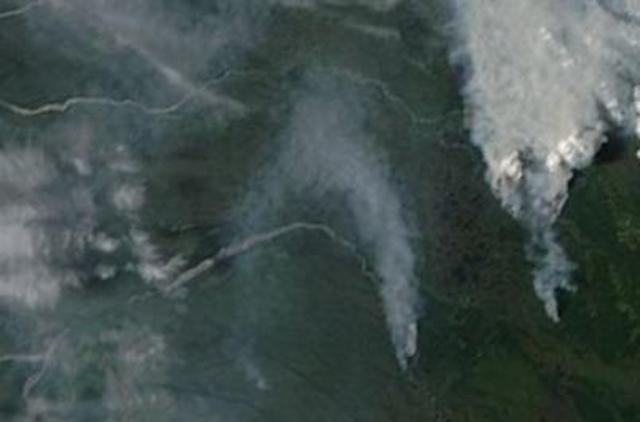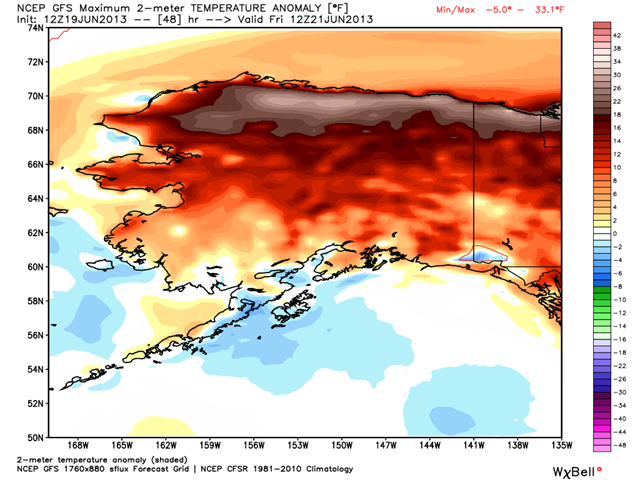Alaska continues to fry, as wildfires flare up
By Jason Samenow
19 June 2013 (Washington Post) – After Monday’s record-breaking temperatures, it remains unseasonably warm in Alaska. And the heat may stick around – at least in the northern part of the state. Writes the NWS office serving Fairbanks: …REGARDLESS OF WHICH MODEL IS FOLLOWED…ALL OF THEM SPELL EXTREME HEAT FOR NORTHERN ALASKA ALL THE WAY THROUGH THE MID RANGE MODELS. THERE IS SOME DEVIATION IN TERMS OF HOW HOT…BUT RECORD BREAKING HEAT IS LIKELY THROUGH AT LEAST THE END OF THE MONTH ACCORDING TO ALL OF THE MODEL RUNS. THE GFS DOES PROPOSE A SLIGHT COOL DOWN OVER THE WEEKEND BUT THEN RAMPS THE HEAT RIGHT BACK UP TO WHERE IT CURRENTLY IS BEGINNING MONDAY. Through next Tuesday, as far out as it forecasts, the NWS calls for highs in Fairbanks between between 80 and 90 degrees. Normal highs there are in the low 70s. [more]
Alaska continues to fry, as wildfires flare up 
By Dr. Jeff Masters
19 June 2013 (wunderground.com) – Alaska is a land of extremes, but the weather of the past month has been truly exceptional. An intense ridge of high pressure, part of an extreme jet stream pattern that has become “stuck” in place for many days, is creating the state’s hottest heat wave in 44 years this week. Numerous cities in Alaska have recorded their all-time hottest temperatures on record, and according to wunderground’s weather historian, Christopher C. Burt, the unofficial 98° measured at Bentalit Lodge on Monday, June 17, ties the record for the hottest reliably measured temperature in state history. The only other time Alaska has been this hot was on June 15, 1969, when the mercury hit 96° in Fairbanks, and a 98° reading was recorded in Richardson (near Fairbanks.) Mr. Burt writes: One thing that is so astonishing about the current heat wave in Alaska is how abnormally cold it was just a month ago. McGrath, which reached its all-time record high of 94° on Monday, recorded a 15° temperature on May 18th, the coldest temperature (by 4°) ever measured so late in the season there (McGrath went on to reach 86° on May 29th, its warmest May temperature on record!). [more]
Baked Alaska: 98° Reading Ties All-Time State Heat Record 
By Robert Scribbler
26 June 2013
(robertscribbler.wordpress.com) – A week after a record heatwave set off highest ever temperatures in Alaska, massive forest fires are blanketing vast areas of wilderness. More than 80 fires are now raging across the state. The largest include the Lime Hills Fire at 154,000 acres and the Moore Creek Fire at 126,00o acres. In total, nearly 400,000 acres have burned so far this summer. For reference, an average full fire season in the US results in around 3 million acres burned. So the 400,000 acres for Alaska alone represents an abnormally large area burned, especially so early in the fire season and for a region at or above the Arctic Circle. Like Colorado, where blazes resulted in record damage during June, the largest of the Alaskan fires, Lime Hills, currently threatens a local community. As of Tuesday, the fire had moved to within a half mile of the town which is located on the upper Stoney River just west of Fairbanks. About 70 firefighters are working to ensure no structures are taken by the blaze. Though not as hot as last week, temperatures still remain in the range of record heat for interior Alaska with some regions Tuesday showing temperatures near 80 degrees (Fahrenheit). Daily record highs for this area range in the high 70s for this time of year. So record-breaking temperatures have become a day-to-day event for this Arctic region. Fires in Alaska are a direct result of the extreme record high temperatures there. And these temperatures are also linked to a long-period warming trend caused by human-spurred global warming. Increasing heat, dryness and wildfires in vulnerable regions are just one result of the climate change caused by an excessive and continuous burning of fossil fuels. May of 2013 was the 3rd hottest on record, according to NOAA’s National Climate Data Center. Overall, temperatures are about .8 degrees Celsius above temperatures when climate records started in the 1880s. This difference is equivalent to that caused by the Little Ice Age, but on the side of hot. [more]
Massive Wildfires Follow Record-Shattering Heat-Wave in Alaska
